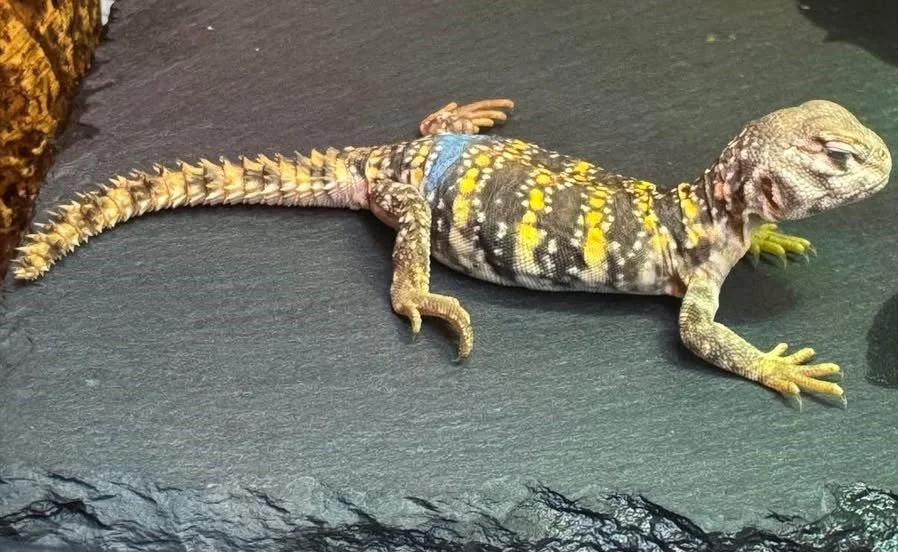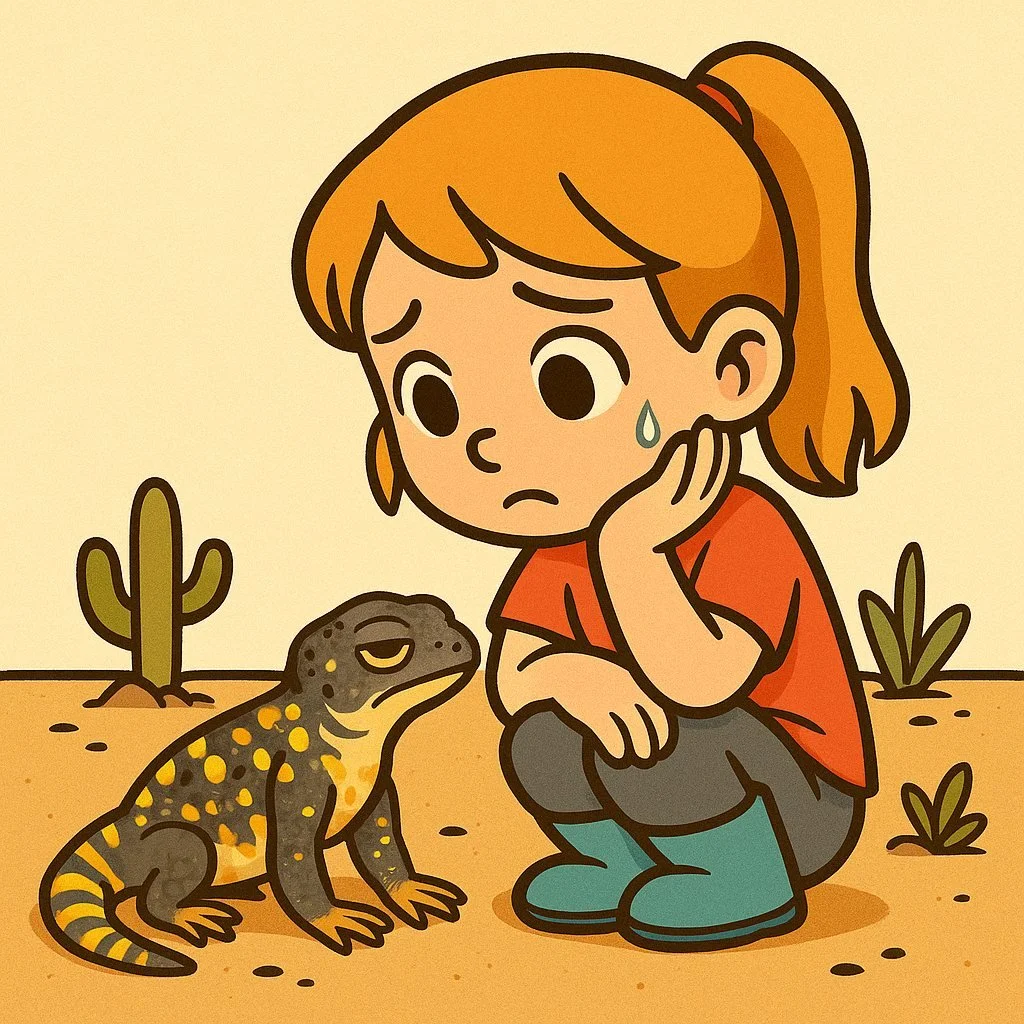Baloo's Big Adventure: A Tiny Dino's Triumph
Baloo, our baby Uromastyx Geyri, had a rocky start as the last to hatch and a reluctant eater. With a little AI-guided insights, a splash of Pedialyte, and plenty of TLC, Baloo’s now starting to come around and embrace its inner gremlin – a tiny bit. Join us for a heartwarming tale of tiny dino triumph!
Waking a Sleeping Dino
Hey there, fellow dino enthusiasts! It’s time for another update from the Tiny Dino Squad headquarters, and boy, do we have some interesting, and hopefully insightful, news to share. If you’ve been following along, you’ll remember our last post where we introduced you to our adorable baby Uromastyx Geyri - 12 little spiky-tailed wonders that have completely stolen our hearts. But among the joy and chaos of raising these mini dinos, there was one little guy who has been keeping us on our toes: the last to hatch, our sweet Baloo.
Well, grab a cup of tea (or a Pedialyte, if you’re feeling adventurous), because today’s post is all about Baloo’s journey from a sleepy, slow-moving baby to a greens-gobbling gremlin in the making as we continue to hand feed him electrolytes and greens. Spoiler alert: it involves some creative problem-solving, a dash of AI magic, and a whole lot of love. Let’s dive in!
A Tiny Dino in Need: Baloo’s Story
When we last left off, we were keeping a close eye on one of our baby Uromastyx - marked with a blue horizontal line in our notes and officially named Baloo (because it’s got that chill, laid-back vibe and a blue mark). Unlike the siblings, who were zipping around like tiny maniacs and devouring their greens like there was no tomorrow, Baloo was… well, different. Baloo was the last to hatch, popping out on day 81 of incubation (a bit later than the usual 65–80-day range), and from the start, it seemed content to bask lazily while the brothers and sisters scampered about.
At first, we thought maybe Baloo was just the mellow one of the bunch. We’d already been amazed by Small Fry, our 3-gram runt who was holding its own like a champ despite its size. But as the days went by, we noticed Baloo wasn’t eating. Not a single nibble. While the rest of the squad turned into little gremlins at mealtime, Baloo would just sit there, uninterested. Naturally, this made us worried. Nursing Baloo back to health quickly became our #1 priority, and we knew we had to figure out what was going on - and fast.
The Quest for Answers: Why AI Became Our Best Friend
If you’ve ever tried googling something super specific - like “complications in late-hatching Uromastyx Geyri” - you know the internet can be a bit of a letdown. There is tons of info out there on popular pet reptiles like leopard geckos, bearded dragons, and ball pythons - think detailed care guides and endless YouTube tutorials. But when it comes to Uromastyx and potential complications? The pickings are slim.
We did stumble across some videos and articles about syringe-feeding reptiles, but they mostly focused on bug-eaters, using stuff like Pangea Gecko Diet or protein-packed pastes. Uromastyx, though, are mostly strict vegetarians - our little herbivores wouldn’t touch that stuff with a ten-foot pole. It is not out of the ordinary to eat a bug or two in the wild, and even as a treat in captivity, but starting their life off on their main diet staple, leafy greens in this case, is what is necessary. At the end of the search, we needed answers tailored to our spiky-tailed friends, and traditional searches were coming up empty.
That’s when we turned to AI (Artificial Intelligence). Why? Because AI can dig deep and process info way faster than your average human reptile caregiver (no offense to our fellow dino parents) and we needed answers quickly. We figured if anything could help us crack the case, it was this new high-tech sidekick. It’s 2025, in the next 10 years humans or perhaps an AI driven robot may end up on Mars - you got to embrace and teach change! As long as you use common sense and conceptually understand what it is you are looking for, then AI can be a very handy tool. Especially as it’s evolved to provide links to sources that it compiles results from that you can use to fact check. It’s the Google of the future, and in fact if you notice Google already provides an AI write up based on what you are looking for if you ask it particular questions!
Adventures in AI Prompting
So, we started with the obvious question: What is different about Baloo? Small Fry was tiny but mighty, running around and chowing down with the best of them. Baloo, on the other hand, was larger but lethargic. Could the extra time in the egg - hatching on day 81 - be the culprit?
We asked AI: What complications might arise for hatchlings who spend longer in the egg? After a few moments of data processing, the answer was a goldmine of info, complete with reference links. Here’s what we learned:
Developmental Abnormalities: Prolonged incubation could lead to physical deformities, like malformed limbs or tails.
Our Observations: Baloo had a lighter-colored head than its siblings, but otherwise, looked normal - no wonky limbs or tails here. In fact as of late we have noticed a darker color starting to show on Baloo’s head – hopefully signs of progress.
Weakness and Reduced Vitality: Late hatchlings might be weaker, struggling to feed or move, which could affect their survival.
Our Observations: Jackpot. This fit Baloo to a T. Baloo move okay – albeit slow and calculated - but isn’t as active as the others, and its lack of interest in food was a big red flag.
Increased Disease Susceptibility: Extra egg time could raise the risk of infections.
Our Observations: We’re not vets – yet as one day Kiley hopes to be - and its early days, but Baloo didn’t seem sick - just tired and lethargic.
Slower Growth Rate: Delayed hatching might mean slower growth over time.
Our Observations: Baloo was one of the bigger babies at hatching time, so we’ll keep weighing and measuring to see how it continues to grow.
Behavioral Issues: There could be quirks in behavior, though hard data on Uromastyx is scarce.
Our Observations: Baloo was super passive, letting siblings pile on top without a peep. Conflict? Not Baloo’s style.
The weakness and reduced vitality - angle felt like our best lead. Baloo wasn’t sick or deformed - just… sluggish. So, we dove back into AI with a new mission: How do we perk this little one up?
The Pedialyte Miracle: How We Got Baloo to Eat
AI came through with a gem: Pedialyte. Yep, that electrolyte drink for dehydrated kids doubles as a reptile pick-me-up. It’s perfect for boosting energy and stimulating appetite in lethargic hatchlings. After some quick fact checking through various source links, we were sold.
We filled a baby syringe with Pedialyte and offered it to Baloo. At first, it gave us the cold shoulder (typical Baloo), but after a few moments - magic. Baloo started lapping it up off Dad’s finger like a pro, going strong for five whole minutes. We were over the moon - our little sloth was finally showing some spark!
But would this translate to food? Dad grabbed some greens and tried hand-feeding next. No dice - Baloo wasn’t having it. Then, in a stroke of genius, Dad dribbled a little Pedialyte onto the green. Boom! Baloo snapped to attention and chowed down, finishing it off like a champ. Even better? Dad fed it a couple more greens - no Pedialyte this time - and Baloo kept gobbling them up. It was like a switch had flipped, and our sleepy baby was suddenly a greens-loving gremlin.
The Road Ahead: Baloo’s Path to Gremlin Hopeful
We’re thrilled to report Baloo’s making great progress, and we’re not stopping now. Our plan is to keep feeding Baloo this way - using a little Pedialyte to kickstart its appetite - until its ready to join the pile of gremlins at mealtime. Baloo has since been moved to its own enclosure so that we can keep a close eye on whether we see signs of eating on its own, pooping, and movement. This is best, as we can keep the rest of the gremlins from pestering Baloo until we feel it’s ready to rejoin the pack.
We’ll keep weighing and measuring Baloo alongside the siblings to track growth, and if it needs extra TLC, we’re all in. After all, raising these tiny dinos is a labor of love - and Baloo’s worth every second.
Lessons Learned: AI, Pedialyte, and Dino Determination
This adventure has taught us a ton:
AI Is a Game-Changer: When the usual sources fail, AI can swoop in and help with answers. It helped us pinpoint Baloo’s issue and find a potential solution fast. Obviously use common sense, trust your gut, and do lots of fact checking! Don’t let AI supplant a good Veterinarian or a Financial Advisor!
Pedialyte FTW: This stuff is liquid gold for tired reptiles. We’re keeping a bottle handy from now on. In fact, Baloo’s momma, Eevee, was introduced to Pedialyte post clutch laying. We sprit’s her greens with it for a few days following to help rehydrate the poor deflated momma!
Patience Is Key: Raising baby Uromastyx isn’t always smooth sailing, but a little ingenuity and a lot of heart go a long way.
Got Uromastyx tips or stories of your own? We’d love to hear them! Drop us a line on Facebook or via the "Contact Us" form on our site. Your wisdom could help us - and other dino parents - on this wild ride.
To all the newbies out there prepping for your own clutch: don’t be afraid to get creative. Sometimes the best solutions come from unexpected places - like a bottle of Pedialyte or a clever AI prompt.
Here’s to Baloo, our late-blooming star, and its journey to gremlin greatness. Stay tuned for more Tiny Dino Squad updates!
P.S. Got a funny or heartwarming reptile tale? Share it in the comments of our Facebook posting for this blog or shoot us a message - we’re all about swapping stories in this scaly community!










